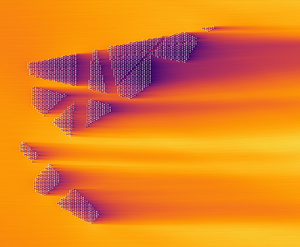Current Research Projects
-
TopoPro
![]()
![]()
![]()
Improved numerical site assessment and load calculation for complex topography (TopoPro)
Because site assessment for wind turbines with the conventional RANS-based methods is not sufficient in complex topography, the goal of this project is to qualify a turbulence resolving, LES-based prediction method. To that end PALM will be prepared and optimized for industrial use. In cooperation with the USTUTT-IAG (https://www.iag.uni-stuttgart.de/), PALM will be coupled with the turbine simulation tool FLOWer in order to improve yield prediction.
Using measured data from the WINSENT test site (https://www.windfors.de/en/projects/test-site/winsent/), the combined influence of topography (including tall vegetation) and atmospheric stability on the flow field, turbulence, as well as the resulting effects on wind turbines are investigated. -
EUPHORIC
The effect of roof-mounted photo-voltaic modules on the urban microclimate and indoor thermal comfort (EUPHORIC)
EUPHORIC is a DFG-funded research project in cooperation with the Physikalisch-Technische Bundesanstalt in Braunschweig and the Technische Universität Dresden. The project aims at investigating the effect of area-wide photovoltaics (PV) deployment in urban areas on the outdoor and indoor urban microclimate in terms of thermal comfort and air quality. For this purpose, we want to implement a new parameterization for roof-top PV panels in the Large-Eddy Simulation Model PALM to simulate and analyse the effects of the widespread use of PV modules under realistic atmospheric conditions.
-
StadtKlimaNDS
Urban Weather Forecasting and Climate Adaptation Strategies for Lower Saxony (StadtKlimaNDS)
StadtKlimaNDS is a project funded by the state of Lower Saxony through the Lower Saxony Competence Center for Climate Change (NIKO). The purpose of this project is to contribute significant supplemental information on the adaptation of Lower Saxony cities to climate change, with a focus on increasing temperatures and periods of heat and drought. For this purpose, the urban climate model PALM will be coupled to the weather forecast model ICON-D2 from the German Weather Service. This coupling will create a high-resolution urban weather model for the operational warning of heat and drought stress. In addition, model simulations will be used to investigate adaptation and mitigation strategies for urban areas.
-
LeonA
![]()
![]()
![]()
Large-eddy simulation study on wake effects of RV Polarstern and implications for in-situ measurments during MOSAiC (LeonA)
The LeonA project aims to investigate the potential impact of the research vessel Polarstern on in situ observations during the MOSAiC expedition.
Details
-
MOSAIK-2
![]()
![]()
![]()
Model-based Urban Planning and Application in Climate Change (MOSAIK-2)
MOSAIK-2 is a German research project within the framework of the joint project "Urban Climate in Change"-[UC]² which aims to develop the urban climate model PALM-4U and to establish it as an operational tool for municipalities and urban planners.
Details
-
Wind Farm-Footprint
![]()
![]()
![]()
Wind farm footprint: Investigation of wake flows from large offshore wind farms
The aim of this project is to better estimate the power losses of the newly planned wind farms in the North Sea and Baltic Sea, as the newly constructed wind farms are located in the delayed wake of the surrounding wind farms.
Details
-
LEAF
![]()
![]()
![]()
Large-eddy simulation study on the effect of vehicle-induced turbulence and exhaust fumes on wind flow and pollutant dispersion in urban street canyons (LEAF)
The main objective of the project is to assess the impact of traffic-induced turbulence and exhaust gases on the turbulent flow and transport of pollutants in urban street canyons using high-resolution Large-Eddy simulations (LES), taking into account the effects of vegetation and atmospheric stability.
-
Drone WAVES
Drone Weather and Artifical Vision-Enabled Safety (Drone WAVES)
The research associated with this project shall enable the establishment of a prototype system of meteorological support for Urban Air Mobility (UAM), package delivery services and other drone missions within urban environments. The investigations are conducted together with Boeing for cities, where first UAM systems are planned or already installed (e.g., Hong Kong or Dubai). The focus is on the turbulent wind field because it is the most crucial meteorological parameter that must be considered for drone operations in cites.
Details
-
USEPE
U-space Separation in Europe (USEPE)
USEPE is an Exploratory Research Project funded by the SESAR Joint Undertaking. It aims at exploring potential separation methods for drones (from each other and from manned aviation) to ensure the safety of drone operations in urban environments, with a particular focus on densely populated areas and turbulent wind field related risks.
Details
-
Dust-Devil Like Vortices
![]()
![]()
![]()
The Formation, Evolution and Properties of Dust Devil-Like Vortices in Convective Boundary Layers - A Study Using High-Resolution Large-Eddy Simulation and Direct Numerical Simulation
The aim of this study is to provide new insights about the atmospheric boundary layer phenomenon of a dust devil with a focus on its properties, the causes of its formation, maintenance mechanisms and its importance for weather and climate considerations. This is done in cooperation with the Ilmenau Fass working group at the Technical University of Ilmenau, which is responsible for the experimental research work.
Details
-
INCITEFOG
![]()
![]()
![]()
High-resolution numerical studies on the effect of turbulence on nocturnal radiation fogs
The aim of this study is to obtain a comprehensive overview of the key parameters that determine the life cycle of radiation fog and its three-dimensional macro- and microstructure.
Details
-
IndiAnaWind
![]()
![]()
![]()
IndiAnaWind: Interdisciplinary analysis and optimisation of wind turbines and their components
The IndiAnaWind joint project led by Enercon brings together the disciplines of meteorology, aerodynamics, aeroacoustics, structure, turbine control and terrain simulations to analyse and optimise wind turbines and their components.
Details
-
LES - ISOBAR
Large-eddy simulations of the polar boundary layer during the ISOBAR measurement campaigns and test of the gradient-based similarity concept under stable conditions
The goal of the project is to use the LES model PALM to simulate selected boundary layers as observed during ISOBAR campaign (Hailuoto, Finland - February 2017 and 2018) in search for physical explanations for the observed boundary layer features. Furthermore, the gradient-based similarity relationships shall be calculated based on LES data and compared against those from ISOBAR data. Finally, the gradient-based similarity relationships shall be implemented in PALM as a surface boundary condition in search for a more reliable performance when simulating very stable conditions.





















